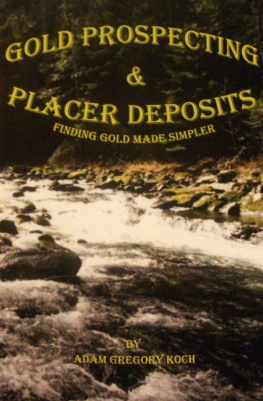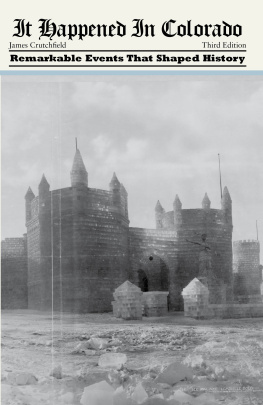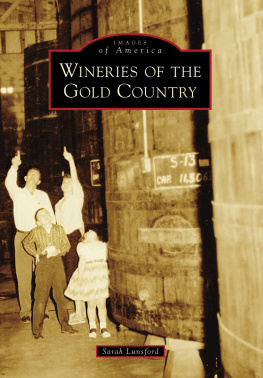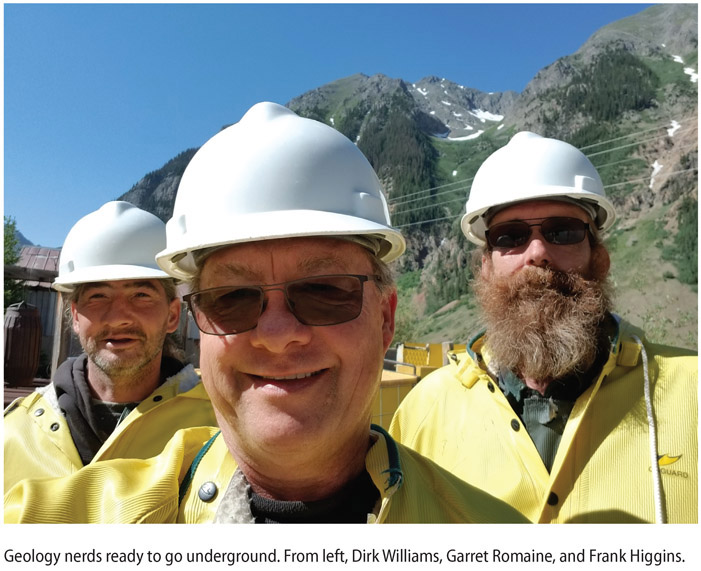ABOUT THE AUTHOR
Garret Romaine is an avid gold prospector, rockhound, and fossil collector with years of experience in the field. He is a longtime writer for Gold Prospectors magazine and is the author of Gold Panning the Pacific Northwest; Gold Panning California; The Modern Rockhounding and Prospecting Handbook; Rocks, Gems, and Minerals of the Southwest; Rocks, Gems, and Minerals of the Rocky Mountains; and Rockhounding Idaho, all from FalconGuides, as well as Gem Trails of Washington and Gem Trails of Oregon. Garret is the Secretary of the Board of Directors for the Rice Northwest Museum of Rocks and Minerals in Hillsboro, Oregon.
ACKNOWLEDGMENTS
I first dipped a pan in Colorado gravels in the 1990s, and Ive come to greatly enjoy the time Ive spent scouting around this great state. It has been a fascinating journey to far-flung old camps and abandoned mines and a true test for my Jeep, affectionately named Cherry Blossom.
Heres a genuine recon salute to the many folks who helped me out in the field, but especially two great mining buddies: Frank Higgins and Dirk Williams. Theyre good sports about going on frantic recon patrols, but they would much prefer to hunker down in a single spot for an entire week. Well, this time we got to. Heres a salute to patient road trip companions, great campers, and strong backs when it comes to shoveling.
Special thanks go to my long-suffering wife, Cindy Romaine, who consented to my extended absence. Shes now officially up for sainthood.
APPENDIX A: MODERN TOOLS
In my companion book, The Modern Rockhounding and Prospecting Handbook, available through FalconGuides, youll learn the basics of reading geology maps, understanding symbols, figuring out basic geology, and more. In this section, youll find overview information about various types of machines and devices that are out there.
One of the great joys of this hobby is sitting around the campfire after a long day and playing with your concentrates. (Second to that joy is doing the same thing in your garage, but campfires are better.) I like to bring buckets and a panning tub on my trips so that I can set up an area where I can screen and clean up the black sands and inspect the tailings with a hand lens for interesting rocks and minerals. At times Ive had to dump the beer cans out of a cooler and use that for a panning station, however.
Buckets, Shovels, Picks, and Screens
Ive met quite a few prospectors who enjoy bringing home a nice bucket of concentrates and then pan in the warmth of their garage. They dont like stretching out into a creek or river, trying to find a deep spot or risking a bad back, and they dont like getting their clothes and shoes wet when they inevitably slip. At home you can use warm water, stay out of the wind, put your panning tub up on a bench, add a drop of dispersant such as Jet-Dry to cut down on surface tension, and bring in plenty of light. So the first tools you need out there are buckets, a shovel, a pick for crevicing, and a screen.
Truthfully, screens are optional but a good idea, so you arent bringing home a bunch of big rocks that you dont really need. Since the odds are billions and billions to one that youll ever screen a big nugget, you might as well use screens to improve the quality of your pay dirtwhether you pan it out in the field or bring it home. Having said all that, fine gold can stick to rocks, so wash them off if you have the patience, with a scrub brush, old toothbrush, or similar tool. Youll know from the gold youre recovering whether a screen could catch big gold at your locale.
Shovels, buckets, picks, and screens do not require a dredging permit, and theyre quiet. Your goal is to dig a big hole, because the deeper you go, the bigger the gold in 99 percent of the deposits. So its up to you whether you bring the same shovel that you use in the garden or get a shorter shovel with a nice handle. On some trips you may use a trowel more than any other shovel, especially if you are digging out crevices in bedrock. The more you dig, and the deeper you go, the better your chances, so these are your first tools to consider.
Gold Pans
Your main tool is the venerable gold pan. Some older folks skip this step and go straight to spiral pans, saving wear and tear on their back, shoulders, and arms, but every prospector should have a pan or two in their collection.
The only way to get good at gold prospecting is through practiceyou have to pan at least a dozen pans before you start to feel comfortable with sliding the heavies around, breaking up the muck, and trusting the riffles. There are twenty or more modern pan designs now, with sharp riffles, double sets of riffles for rough and fine panning, and all kinds of interesting shapes and additions. My personal favorite right now is a 14-inch octagonal pan with two sets of riffles and a broad, flat bottom. This pan helps with avoiding the tendency to swirl material in a circular pattern, which only serves to spread the concentrates around on the bottom. What you want to do is continually push heavy material into the first riffle and lock it in there, so you can start to feel more nonchalant about everything else in the pan.
When you are first breaking down a big pan full of muck, you need to learn to shake the pan vigorously so that the heavy material at the bottom slides forward to that first notch. This is called stratifying, and it only works when you get the muck entirely into solution so that its behaving like a liquid. Once you get your material into suspension, gravity will pull things apart, with light material like clay and debris floating to the top and heavy material like gold, garnets, and black sands falling to the bottom. So you want to do less swirling as you get closer to the end, and more side-to-side action. Pack that first riffle, and trust science.
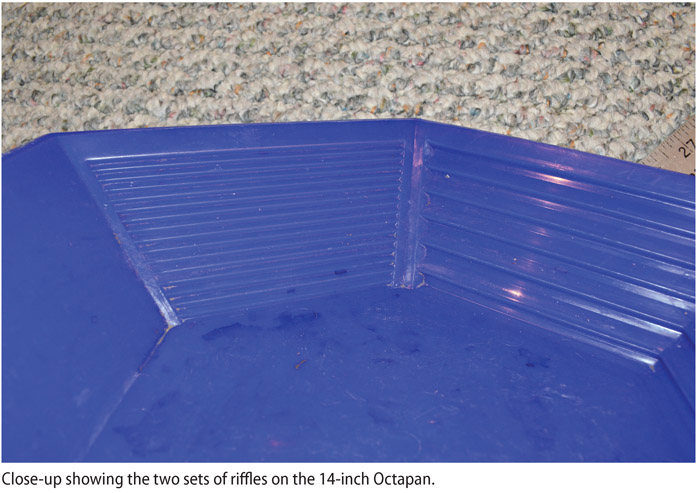
The great thing about panning is that its easy, and its almost never banned. Even Wild and Scenic Rivers are open to panning below the high-water line. National parks and monuments are not open, however. State parks also tend to restrict panning, but county parks and USFS and BLM landseven campgroundsare usually open, and campgrounds are rarely claimed. So its the first skill you need to gain as a prospector.
Snuffer Bottles
Once youve panned down a pan to where you can see what you have, you need some way to save the sample. You can use a wide-mouthed glass jar and just dump your concentrates in, although its good to have a second pan underneath the jar. Most modern prospectors use a snuffer bottle, which is a small plastic bottle with a removable straw. Once youre good at it, you can slurp up your black sands quickly, and there are two modeswithout the straw, for bulk recovery, and with the straw, for finer work. Once you get good with a snuffer bottle, you can make your specimen cleaner by, for example, picking up just the black sands and leaving the goldif you have plenty of gold. You can easily fill up the small glass specimen jars by removing the straw and emptying the contents of the snuffer bottle; the heavies will concentrate in the tip. Give it a swirl when youre down to the final material.



